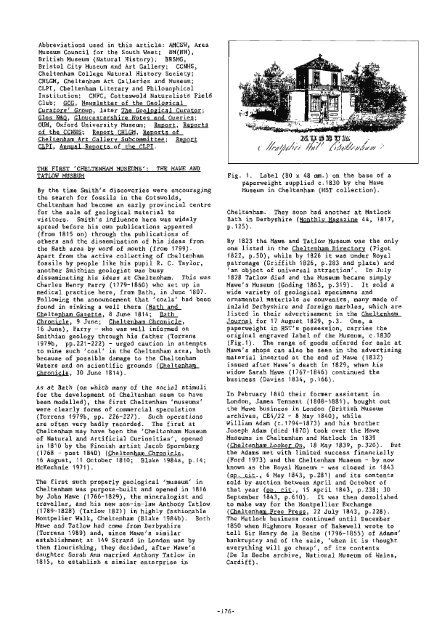Number 5 - Geological Curators Group
Number 5 - Geological Curators Group
Number 5 - Geological Curators Group
Create successful ePaper yourself
Turn your PDF publications into a flip-book with our unique Google optimized e-Paper software.
Abbreviations used in this article: AMCSW, AreaMuseum Council for the South West; BM(NH),British Museum (Natural History); BRSMG,Bristol City Museum and Art Gallery; CCNHS,Cheltenham Colleee Natural Historv Societv: ..CHLGM, Cheltenham Art Galleries and Museum;CLPI, Cheltenham Literarv and PhilosophicalInstitution; CNFC, ~otteswold ~aturaiists FieldClub; a, Newsletter of the Geolo~ical<strong>Curators</strong>' Groue, laler The Gcolueical Curotor;Glos N&O, Gloucesrershire Notes and Oueries;OUM, Oxford University Museum; Revort, Reportsof the CCNHS; ~evort CHLGM, Renorts ofCheltenham Art Gallerv Subcommittee;m, Annual Reports of the CLPI.TATLOW MUSEUMBy the time Smith's discoveries were encouragingthe search for fossils in the Cotswolds,Cheltenham had become an early provincial centrefor the sale of geological material tovisitors. Smith's influence here was widelyspread before his own publications appeared(from 1815 on) through the publications ofothers and the dissemination of his ideas fromthe Bath area by word of mouth (from 1799).Apart from the active collecting of Cheltenhamfossils by people like his pupil R. C. Taylor,another Smithian geologist was busydisseminating his ideas at Cheltenham. This wasCharles Henry Parry (1779-1860) who set up inmedical practice here, from Bath, in June 1807.Following the announcement that 'coals' had beenfound in sinking a well there (Bath andCheltenham Gazette, 8 June 1814; BathChronicle, 9 June; Cheltenham Chronicle,16 June), Parry - who was well informed onSmithian geology through his father (Tarrens1979h, pp.221-222) - urged caution in attemptsto mine such 'coal' in the Cheltenham area, bothbecause of possible damage to the CheltenhamWaters and on scientific grounds (CheltenhamChronicle, 30 June 1814).As at Bath (on which many of the social stimulifor the development of Cheltenham seem to havebeen modelled), the first Cheltenham 'museums'were clearly forms of commercial speculation(Tarrens 1979b, pp. 226-227). Such operationsare often very badly recorded. The first atCheltenham may have been the 'Cheltenham Museumof Natural and Artificial Curiosities', openedin 1810 bv the Finnish artist Jacob Spornberg -(1768 - pbst 1840) (Cheltenham ~hronikle,16 August, 11 October 1810; Blake 1984a, p.14;McKechnie 1971).The first such properly geological 'museum' inCheltenham was purpose-built and opened in 1816by John Mawe (1766-1829), the mineralogist andtraveller, and his new son-in-law Anthony Tatlow(1789-1828) (Tatlow 1821) in highly fashionableMontpelier Walk, Cheltenham (Blake 1984b). BothMawe and Tatlow had come from Derbyshire(Torrens 1989) and, since Mawe's similarestablishment at 149 Strand in London was bythen flourishing, they decided, after Mawe'sdaughter Sarah Ann married Anthony Tatlow in1815, to establish a similar enterprise inFig. 1. Label (80 x 48 mm.) on the base of apaperweight supplied c.1830 by the MaweMuseum in Cheltenham (HST collection).Cheltenham. They soon had another at MatlockBath in Derbyshire (flontblv Maaazine 44, 1817,p.125).By 1823 the Mawe and Tatlow Museum was the onlyone listed in the C h e l t e n h a m y (Pigot1822, p.50), while by 1826 it was under Royalpatronage (Griffith 1826, p.283 and plate) and'an object of universal attraction'. In July1828 Tatlow died and the Museum became simplyMawe's Museum (Goding 1863, p.319). It sold awide variety of geological specimens andornamental materials as souvenirs, many made ofinlaid Derbyshire and foreign marbles, which arelisted in their advertisement in the CheltenhamJournal for 17 August 1829, p.3. One, apaperweight in HST's possession, carries theoriginal engraved label of the Museum, c.1830Fig.1) The range of goods offered for sale atMawe's shops can also be seen in the advertisingmaterial inserted at the end of Mawe (1832)issued after Mawe's death in 1829, when hiswidow Sarah Mawe (1767-1846) continued thebusiness (Davies 1834, p.166).In February 1840 their former assistant inLondon, James Tennant (1808-1881), bought outthe Mawe business in London (British Museumarchives, CE4/22 - 8 May 1840), whileWilliam Adam (c.1794-1873) and his brotherJaseph Adam (died 1870) took over the MaweMuseums in Cheltenham and Matlock in 1839(Cheltenham Looker On, 18 May 1839, p.320). Butthe Adams met with limited success financially(Ford 1973) and the Cheltenham Museum - by nowknown as the Royal Museum - was closed in 1843(Acit.,6 May 1843, p.281) and its contentssold by auction between April and October ofthat year (d.,15 April 1843, p.238; 30September 1843, p.610). It was then demolishedto make way for the Montpellier Exchange(Cheltenham, 22 July 1843, p.228).The Matlock business continued until December1850 when Highmore Rosser of Bakewell wrote totell Sir Henry de la Beche (1796-1855) of Adams'bankruptcy and of the sale, 'when it is thoughteverything will go cheap', of its contents(De la Beche archive, National Museum of Wales,Cardiff).
















